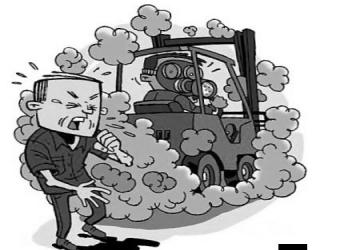
Have you ever noticed how quickly dust starts to build up in your warehouse? Well, beware: that fine layer of dirt is a warning about a much bigger problem – and it’s one your forklift truck is causing.
Dust is unpleasant to work with, and it damages stock – especially in industries where hygiene is important, like food. In others, like paper, dust is made during the process.
But the dust that settles on racking, stock and clothes is just part of the problem – because this is the dust you haven’t already breathed in.
Serious health risks
As well as discomfort and damage, dust can cause serious health problems for people who work with it every day. Problems like asthma, Chronic Obstructive Pulmonary Disease or even scarring.
To protect workers, most countries specify maximum dust concentrations that are allowed in the air. In the UK, it’s a total quantity about the size of a five pence piece, in a room ten feet square. In some industries – for example where there’s wood dust or building materials – the risk is especially serious.
Worryingly, most of the particles are much smaller than you can see with the naked eye, so it’s difficult to tell exactly how much dust is in the air at any one time.
Forklift engines: the cyclone effect
So, what has this got to do with forklift trucks?
Generally speaking, forklift engines don’t create dust – an LPG engine with a three-way catalytic converter doesn’t even make soot. The problem is the way they spread it.

The cyclone effect
The fast-moving parts of the engine create a cyclone effect – a lot like the one used in modern vacuum cleaners – which sucks dust and dirt from the floor. Except, unlike a cleaner, the particles aren’t stored: they’re scattered into the air.
Every time the truck is used, it directly increases the airborne dust concentration; damaging stock and, potentially, workers’ health.
Prevention is simple
The Health & Safety Executive recommends good housekeeping as the best way to keep dust down – but most importantly it says to avoid methods that put settled dust back into the air.
For a forklift truck, that means a belly plate with sealed rear wheel arches. Putting a physical barrier under the truck stops dust and dirt being sucked into the engine and sprayed around – especially if the wheel arches are included. This protection can be fitted to most trucks. It’s a very simple solution to a small but important problem.
Workplace dust: the facts…
- Most dust is a mixture of skin cells, hair, textile fibres, plant pollen and soil. Some work sites add other elements like paper, wood or building materials.
- Dust is tiny. Most is less than 10 microns across: much smaller than you can see with the naked eye, so it’s hard to tell how much there is.
- Dust can be dangerous. Because it’s so small, it settles in the lungs and can cause respiratory diseases and scarring.
- Itching eyes or nose can be a sign that dust is causing an allergic reaction that could develop into asthma.
- Forklifts need belly plates to prevent them picking up dust from the floor, and scattering it into the air.
